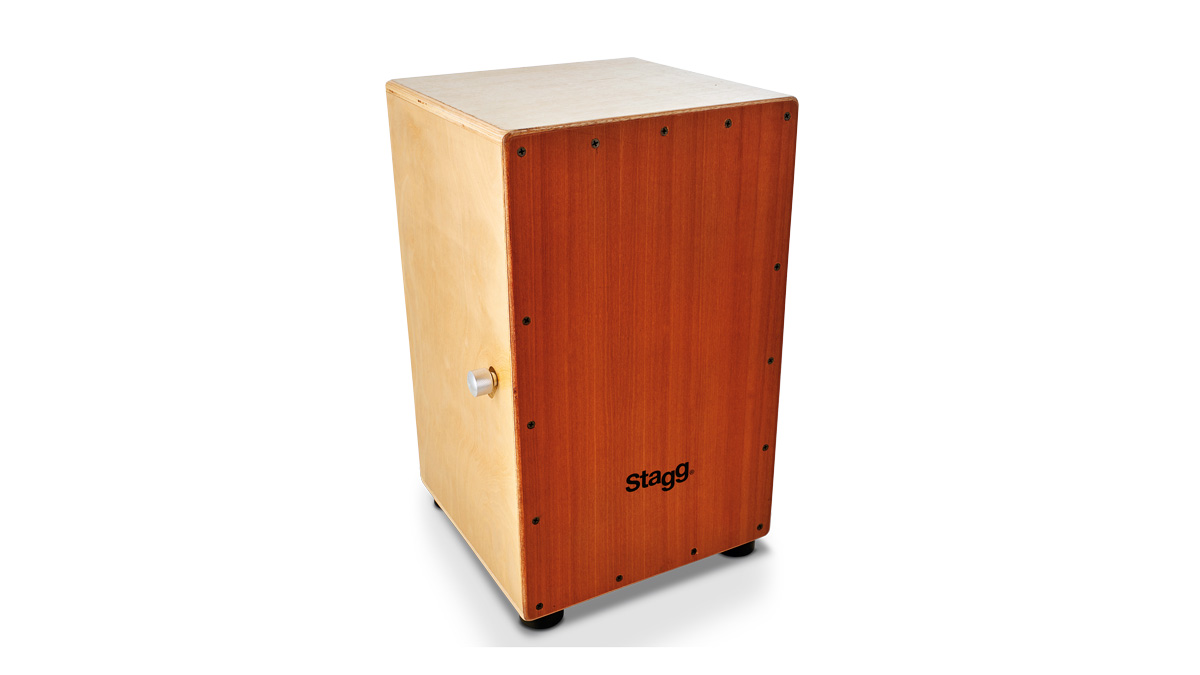MusicRadar Verdict
As ever with Stagg you get a well-made honest product at a price which does not feel like you're being taken for a ride.
Pros
- +
Good price, tone and look.
Cons
- -
Not the most resonant cajon we've heard.
MusicRadar's got your back
Stagg has an enviable reputation for punching above its weight in terms of good value percussion products. Some of its Chinese-made cymbals are real bargains, while even at this low price the CAJ-60M is Stagg's ritziest cajon.
Build
Stagg's forerunning 40M and 50M series cajons are made from MDF and basswood. The 60M is birch ply with a facing veneer 'tapa' of makore (African cherry) wood, which gives it an altogether more up-market image.
The 'M' stands for medium-sized and at 500mm high it's a good compromise, a comfortable height for most. Depth and width are both 200mm, again not-too-small and not-too-big. And the 12mm birch ply body, with strengthened internal joins and support post, seems plenty sturdy enough for plonking your butt down on.
Finish is a matt natural, almost satin lacquer, sanded perfunctorily smooth. Steadying the ship are four good-sized (45mm diameter) round rubber feet, while inside and above the sound hole is glued a rounded reinforcing baton that also provides a handy grip for picking up the instrument.
All Stagg cajons come with a padded nylon carrying bag with shoulder straps. Inevitably it's not the most rugged, but is not to be sniffed at for the price.
Hands On
The fat rubber feet give the 60M a stable base and increased resonance isolation, while the box feels solid even though it is still light and easy to lift.
Even the most 'sophisticated' of cajon snare mechanisms are crude, but this is one of the better designs. Positioned halfway down the right side of the box is a chrome knob in a short curved slot. This controls a steel rod which is connected to the two cut halves of a 20-coil steel snare.
When loosened the knob can slide along the slot, pushing the snares against the inside of the tapa or pulling them away. The knob is then tightened in the preferred position. This is easy to adjust during performance, giving roughly varying degrees of snarey or open sound.
With the snares full on and loosening off the top outer tapa screws just enough to get a crack, we gave the 60M a good pummelling, soon finding the sweet spots for bass and top end: ticky-tacky at the very bottom, reasonably bombastic centrally, clattery at the top. It's not the most resonant or tone-rich of cajons, but it has character.
Releasing the snares makes as great a sound change as on your standard snare drum. Impressively, the sound opens right out, the bass much more hollow and clean, rounded with a woody and medium-deep note. With the snare back on, the bass is more rattly, but fatter and swampier.
It's not too crisp, but rather crunchy and funkily loose. Both sounds have their place and contribute to the 60M's versatility.
““We were arguing a lot and we were miserable”: How Green Day exceeded expectations with their most ambitious song
"There’s plenty for us guitarists to learn – and ‘less is more’ is the overriding lesson": how to play like George Harrison on The Beatles' Abbey Road
“They didn’t like Prince’s bikini underwear”: Prince’s support sets for the The Rolling Stones in 1981 are remembered as disastrous, but guitarist Dez Dickerson says that the the crowd reaction wasn’t as bad as people think










